Hyundai to build ITER vacuum vessel
Today, 15 January 2010, a contract has been signed between Gyung-Su Lee, President of Korea's National Fusion Research Institute (NFRI) and Hyundai Heavy Industries (HHI) for the Korean sections of the ITER vacuum vessel and ports. Both are critical components of the ITER Tokamak.
Hyundai Heavy Industries will participate in the construction of the vacuum vessel for ITER in recognition of its technological capabilities as demonstrated by its experience with KSTAR. The company will construct and deliver two of the nine vacuum vessel sectors, the seventeen equatorial ports, and the nine lower ports of the ITER Tokamak by early 2017.
Of the ten main procurement items to be procured "in-kind" by Korea, the vacuum vessel sectors along with the toroidal field conductor are the principal long-lead items to be delivered early in the construction of ITER.
The vacuum vessel encloses the space where high temperature plasma will be created and maintained to produce fusion reactions. As such, it is designed to withstand both extremely high and cryogenically-low temperatures while maintaining a high vacuum seal.
"Domestic companies that have accumulated technological competence through the experience of KSTAR are now participating in ITER," stated President Lee. "Developments in new fusion technology by industry are expected to advance national development toward becoming an international leader in fusion."


